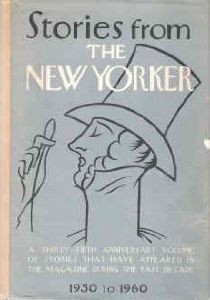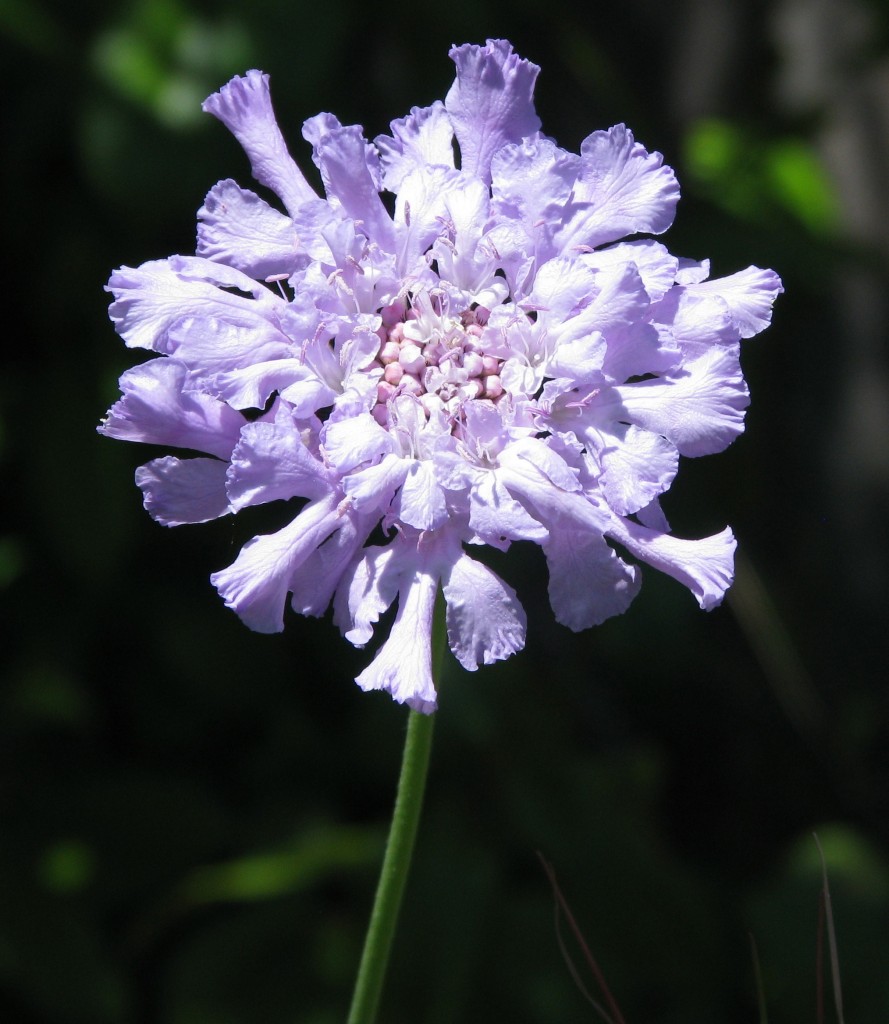
My Two Gardeners rabbit trail has taken a delicious turn down a literary lane…
Nov. 1960. Katharine White to Elizabeth Lawrence, regarding Katharine’s latest “Onward and Upward in the Garden Column” in the New Yorker:
Then another thing I did wrong, apparently, was to give the impression by my wording on Gertrude Jekyll that England had never had naturalized plantings until Robinson and Jekyll came along. Of course it had, and I knew it. I’m not learned enough to know where the craze for bedding out and for copying formal European gardens started but I remembered a passage in Mansfield Park where all the Bertrams and the Crawfords and poor Fanny Price went to spend the day at Mr. Rushworth’s estate to consider how to remake his landscaping and gardens, and Fanny mourned because Henry Crawford recommended cutting down an avenue of old trees. This made me wonder whether it was not between 1800 and 1820 that this all started. Jane Austen commenced this novel in 1811 and it was published in 1814. Do you, with your real learning, know about this? I would love to use the reference to Mansfield Park (and some others in the Austen novels) in a later piece if by any chance my hunch is right that Jane was satirizing a new fad in gardens…
Elizabeth replies:
I’ll lend you an article I have on Repton and Jane Austen, and I think it will answer all your questions….
The “naturalistic movement” came at the end of the the seventeenth century with the Earl of Shaftesbury, Addison and Pope. but it wasn’t very natural, I gather: ruins, romance and rustic seats.
[An aside. Later in the letter, Elizabeth adds a word of comfort for her meticulous friend’s consternation over slight inaccuracies in the New Yorker piece:
I gruel over things as you do, but I learn more by making mistakes than any other way. Even with the greatest care I find errors creep in, and when I learn better I write and correct what I’ve said before. But I try not to let it bother me. Everyone makes mistakes, but the really despicable people are those who protect themselves by never making a definite statement.
Emphasis mine. Oh how I love her!]
Two Gardeners editor Emily Herring Wilson helpfully includes a footnote to let us know that the article on Repton and Jane Austen was a piece by Elsa Rehmann called “Jane Austen and the English Landscape School,” published in Landscape Architecture in 1935. Katharine sends Elizabeth her thanks and expresses a hope to borrow the article until she has a chance to write her next column.
I admit I was crestfallen to find that Jane Austen had been so thoroughly explored, but I also think the author of that piece and even Jane’s famous editor, Chapman, didn’t quite see that the novelist was satirizing a current fad, in somewhat the same way, except more mildly, that she poked fun at the gothic novel. That least that is my theory, probably false…
This sent me looking for a passage I thought was in Sense and Sensibility, in which the odious Fanny Dashwood points out a grove of old trees and casually mentions her plans to have them pulled down and replaced with a Grecian temple. I couldn’t find it on a quick flip-through, though. Perhaps I am only remembering the film? Now that I think about it, I wonder if Emma Thompson borrowed that bit from the Mansfield Park scene Mrs. White describes above.
Well! Look what the Google turned up! I wanted to make sure I was remembering correctly that Emma Thompson wrote the screenplay for S&S. Turns out the entire screenplay is online as a pdf. But with permission? I can’t tell. (A search for “temple” turned up the scene I was remembering—almost word for word!)
Oh, these crazy interwebs.
(Quotes from: Two Gardeners: A Friendship in Letters, edited by Emily Herring Wilson, Beacon Press, 2002.)
Related:
Two Gardeners: A Rabbit Trail
“I have had to give up writing to my close friends”
“In the last decade our fiction writers use only ‘I’…”
Before the Internet
March 27, 2012 @ 6:50 pm | Filed under:
Books 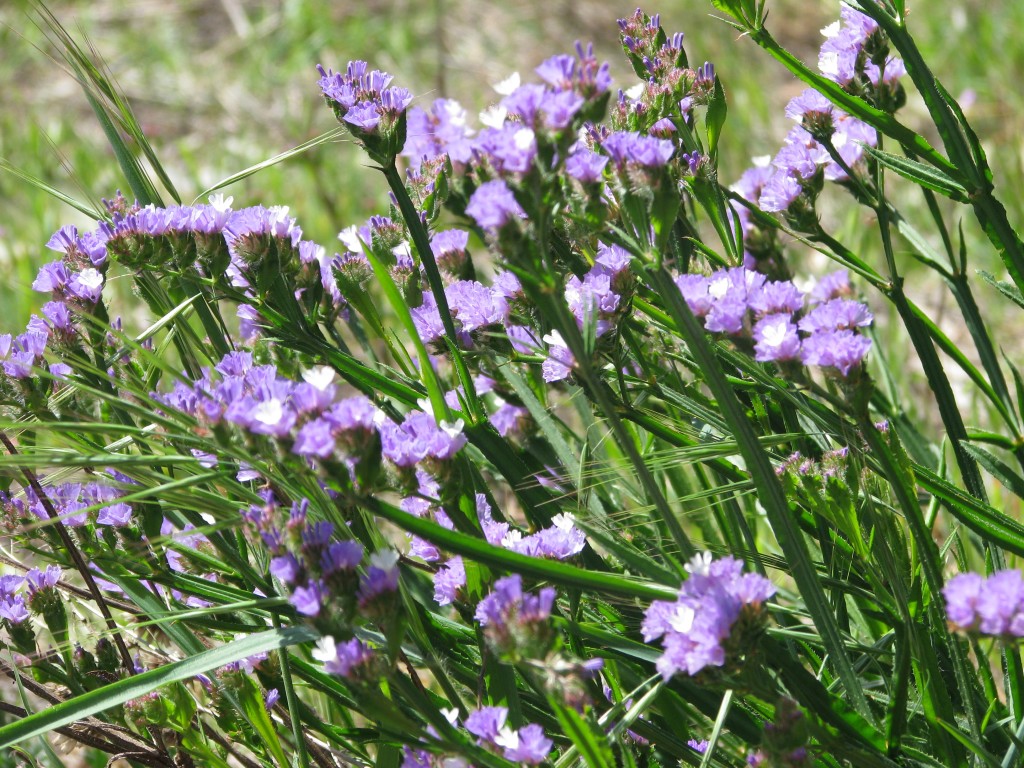
This exchange from Two Gardeners gave me a curious sort of comfort today. May, 1959. They’ve been corresponding occasionally for a year. Katharine writes:
Dear Miss Lawrence,
Can you ever forgive me for having been so rude as not to write you long before now to acknowledge all the helpful things you have done for me and for your good letters and postcards?
She hastens to explain that she had fallen ill and spent a long time recovering from a kidney infection. This apology is followed by several wonderful pages of garden notes and commentary. And finally:
This letter is much too long and I must wind it up fast. Our first calf was born today and another will be along soon…The first bantam chick has cracked its shell and it is suddenly hot, so spring must be here at last. The seventy-five chicks for broilers and laying hens have come out from under the brooder stove. We try to do much too much and our lives are too full. I’m sure yours must be, too, especially when you get letters of this length.
Elizabeth responds:
First, please believe that I never even notice when letters are not answered, much as I love the answers when they come. I can’t bear to think that you would ever have answering on your mind. And in turn please don’t fault me if I don’t answer. If I don’t by return mail, I probably never will. I have had to give up writing letters to my close friends. And answer only business letters; and garden ones, for as you know that is the only way to get any real information.
By this point in the correspondence it is clear they are on their way to becoming real friends—Katharine ends her letter with “And I find myself quoting ‘Elizabeth.’ Do I dare call you that? Anyway, I’ll sign myself, Katharine”; and Elizabeth’s reply opens with “Dear Katharine”—and I love seeing how they’re working out the relationship. The warmth and mutual respect, the delight in finding a conversation partner who brings wit, knowledge, and original thought to the discussion of one’s pet subjects. Surely many of us who’ve connected with one another here in blogland can relate…
And there they are, in the late ’50s, when there were only a handful of television channels, for Pete’s sake, and no internet, no social media, struggling to keep up a valued correspondence in the thick of a busy and sometimes bumpy life.
As I said, comforting indeed.
Have I mentioned lately how much I appreciate your comments here? And how I wish I were better at keeping up my end of these many correspondences, both in the comment box and outside it? 🙂
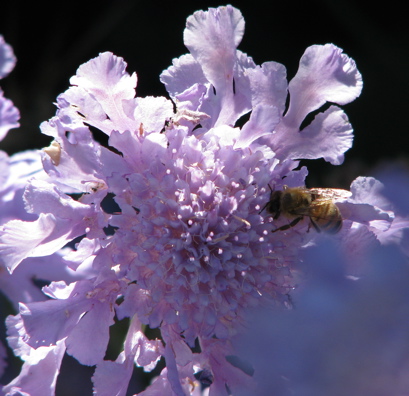
A book arrived yesterday that made me giddy. Scott saw me squealing over it and wanted to know what all the excitement was about. I tried to think how best to explain it to him.
“Okay, imagine that John Lennon and Elvis Presley were pen-pals. Say they had a lively correspondence, letters flying back and forth for years and years. Now imagine that this book is a collection of those letters.”
He raised his eyebrows. “Who are they really?”
I sighed happily. “Katharine White and Elizabeth Lawrence.”
Scott: “Um…?” But he knows me well. “Gardening?”
“Yes. Only my two favorite gardening writers EVER.”
“Like you had to tell me that.”
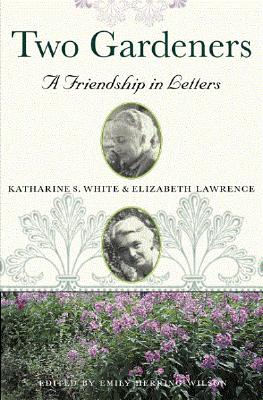 Everything about this book makes me smile. Editor Emily Herring Wilson’s introduction begins,
Everything about this book makes me smile. Editor Emily Herring Wilson’s introduction begins,
Gardeners are often good letter writers, and whether they write to describe what’s blooming today or to remember a flower from childhood, their letters are efforts to preserve memory. After they have put away tools in the shed, they write letters as a way to go on working in the garden. Because it is impossible to achieve the kind of perfection they dream of, they try to come to terms with their dreams by talking back and forth about their successes and failures….
Katharine S. White was, of course, the esteemed New Yorker editor whose occasional gardening columns are collected in the first horticultural tome ever to win my heart: Onward and Upward in the Garden. I had only to read her opening essay, the famous 1958 column that both celebrates and gently mocks gardening catalogs, critiquing them like works of literature, to know that here was a kindred spirit. Evidently Miss Elizabeth Lawrence, a knowledgeable and enthusiastic Southern garden writer (whose Gardening for Love I quoted the other day), felt the same spark of recognition. In May of 1958, Elizabeth wrote Katharine White a letter to say how much she’d enjoyed the New Yorker column, adding,
I asked [my friend] Mrs. Lamm if you were Mrs. E. B. White, and she said you were. So please tell Mr. E. B. that he has three generations of devoted readers in this family. My mother’s favorites were the one about leaving the mirror in the apartment vestibule, and the one about homemade bread. My niece adores Charlotte’s Web.
The mirror and bread essays (“Removal” and “Fro-Joy”) can be found in E. B. White’s One Man’s Meat, and if you know me at all, you know this sort of interwoven rabbit-trailing fills me with utter glee.
That first letter from Elizabeth to Katharine is fun, folksy, and smart, full of suggestions for other garden catalogs Mrs. White might enjoy. Several of her recommendations became fodder for subsequent ‘Onward and Upward’ columns. For nearly twenty years, until Katharine’s death in 1977, the two women wrote back and forth. So far, I have only read the first two of these letters. There must be hundreds of them in this book. I’m positively aflutter over the idea of such riches.
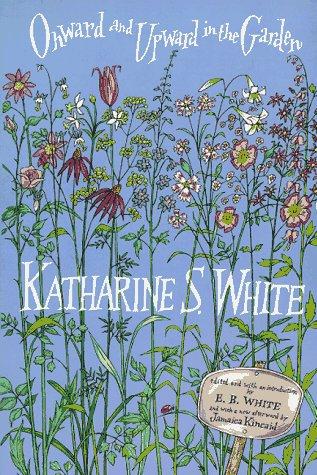 I didn’t get farther than the first letter last night because I found I had to interrupt it in the middle and go reread the Katharine White essay. Which led to another googlesome rabbit trail to see if any of the old catalogs she references can be read online. The Roses of Yesterday and Today catalog, whose author at the time, a Mr. Will Tillotson, had an “informative and occasionally rhapsodic” style that charmed Mrs. White no end, is still around—though Mr. Tillotson died in 1957, a fact Mrs. White adds in a sorrowful postscript at the end of her essay. The 1959 catalog seems to have been reprinted some years back. In her essay, Katharine quotes extensively from the 1955 and 1956 catalogs, which she says she borrowed from a friend, adding, “I must not keep them long, because though she has never bought a Tillotson rose, she reads Tillotson every night before she goes to sleep.”
I didn’t get farther than the first letter last night because I found I had to interrupt it in the middle and go reread the Katharine White essay. Which led to another googlesome rabbit trail to see if any of the old catalogs she references can be read online. The Roses of Yesterday and Today catalog, whose author at the time, a Mr. Will Tillotson, had an “informative and occasionally rhapsodic” style that charmed Mrs. White no end, is still around—though Mr. Tillotson died in 1957, a fact Mrs. White adds in a sorrowful postscript at the end of her essay. The 1959 catalog seems to have been reprinted some years back. In her essay, Katharine quotes extensively from the 1955 and 1956 catalogs, which she says she borrowed from a friend, adding, “I must not keep them long, because though she has never bought a Tillotson rose, she reads Tillotson every night before she goes to sleep.”
Mrs. White is similarly fond of Amos Pettingill, the “peppery” and “highly distinctive” persona holding forth in the pages of the old White Flower Farm catalogs. When I first read Onward and Upward as a college student (avoiding my English lit assignments, no doubt), I immediately sent away for a copy of the current White Flower catalog, even though I had 1) no garden; 2) no money; 3) no business poring over garden catalogs when I ought to have been plowing through my coursework. I can’t remember now whether Amos Pettingill was still dispensing wisdom in its pages. If he was, he had a new ghostwriter by then, since the original Amos, Mr. William Harris—a writer for Fortune magazine (and, with his wife, founder of White Flower Farm)—died while I was still in middle school. The welcome letter at the current White Flower website is signed “Amos Pettingill,” so someone is keeping up the tradition, I see.
Here’s an interesting bit of trivia I learned from the footnotes of Onward and Upward: William Harris’s wife was Jane Grant, a New York Times writer whose first husband was Harold Ross—Katharine White’s boss at The New Yorker. When Katharine wrote that essay, she had no idea she was singing the praises of her boss’s ex-wife’s new husband. Having just learned that Harold Ross was “one of the original members of the Algonquin Round Table,” I can’t help but imagine how Dorothy Parker must have chuckled wickedly when she heard. Because of course Dorothy Parker would have heard.
Elizabeth Lawrence’s taste in garden literature ran in a more down-home direction. Her Gardening for Love (polished and published after her death by Allen Lacy—the third name on my Top Three Garden Writers list) focuses on the advertisements of country farmers and farm wives in agricultural market bulletins. I tried very hard, one summer during graduate school, to track down some of these old bulletins, but that was before the Google and my search was unsatifactory. You can probably get them on eBay now, but I haven’t looked.
Ha, I couldn’t resist, I’ve just gone and looked. Not at eBay: a Google search for “market bulletins” turned up a link to the Louisiana Dept. of Agriculture’s current market bulletin, which you can download just like that. The ads—to which I turned immediately, since those were Miss Lawrence’s special fascination—read exactly like the ones she quotes from the ’50s and ’60s.
“Belinda’s dream rose, knock roses, 6 colors, drift ground cover roses, Little John bottle brush kaleidoscope abelia, Lady Banks roses, Shishi camellia, in 3-gal. containers, $10-$18/1; 30 varieties azaleas-camellias, $4-$25/1. L— C—, Husser, Tangipahoa Parish.”
This very same Louisiana Market Bulletin makes numerous appearances in Gardening for Love. And I know this post is already a giant game of Six Degrees of Separation (where perhaps E. B. White stands in for Kevin Bacon?), but there’s another literary connection worth mentioning: it was Elizabeth Lawrence’s friend Eudora Welty who first introduced her to the market bulletins.
“Years ago Eudora Welty told me about the old ladies who sell flowers through the mail,” writes Miss Lawrence in the opening chapter of Gardening for Love. “She put my name on the mailing list.”
She continues:
Like Eudora’s novels, the market bulletins are a social history of the Deep South. Through them I know the farmers and their dogs, their horses and mules, and the pedigrees of their cattle. I wonder whether the widow with no family ties found a home with an elderly couple needing someone to take care of them; whether the bachelor with no bad habits found a congenial job where the hunting and fishing were good; whether puppies got homes and lost dogs were found. And I wonder who bought the little farm with the pecan trees and good clear well water.
Most of all I like to think about the hard-working farm women who are never too tired, when their farm work is done, to cultivate their flowers gardens. They always find time to gather seeds, to dig and pack plants, and to send them off with friendly letters. To all parts of the country they send them off—yard plants, houseplants, and window plants. Reading the flower lists is like reading poetry, for the flowers are called by their sweet country names, many of them belonging to Shakespeare and the Bible.
Elizabeth Lawrence seems to have enjoyed the correspondence with her “hard-working farm women” as much as she loved their flowers, for the letters she received from them play a huge part in Gardening for Love. “The farm women are great letter writers,” she says, “and usually answer (delightfully and often at length) if a stamped and addressed envelope is enclosed.”
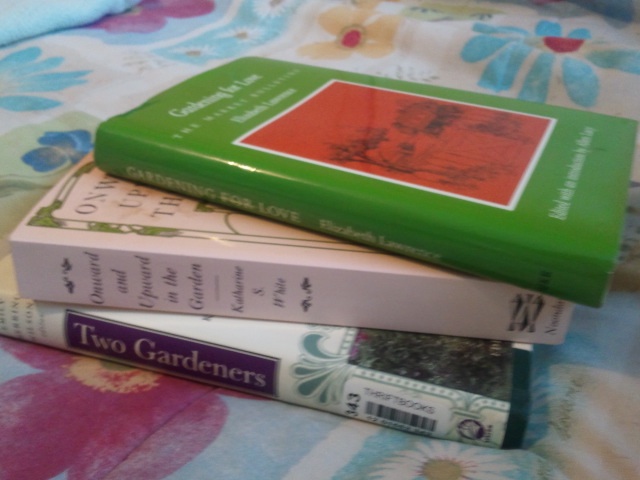
Of course, reading about these correspondences now, in 2012, I can’t help but think about the changed landscape of letters. I’ve never been very good, myself, at putting literal pen to actual paper, let alone following through with a stamp. Take away my keyboard and I go mute. We talk to each other now in blog posts and comment boxes, and in emails, IMs, texts, tweets, status updates—and this thrills me. I’m not a communications neo-Luddite. I love that we have so many ways to connect, nowadays. Still, it’s hard to imagine a collection of emails filling me with the same kind of soaring joy I feel at holding the White-Lawrence correspondence in my hands. “Dear Miss Lawrence,” writes Katharine in reply to Elizabeth’s first missive, “it was delightful to get your your letter…”
Yes, it really was. Now if you’ll excuse me, I think I’ll go read letter number three.


